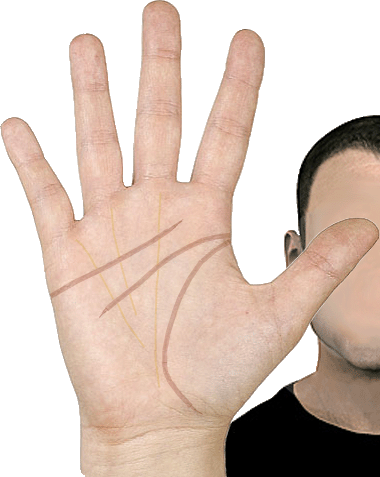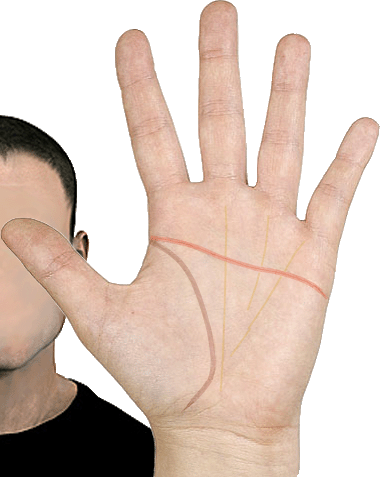SIMIAN LINE - Simian crease prevalence in ethnic populations!

The prevalence of the simian line varies significantly around the world due to a genetic factor associated with ethnicity.
In the work 'Hands: The Complete Book of Palmistry
• Pygmies: 34.7 %
• Gypsies: 14.3 %
• Chinese: 13.0 %
• Koreans: 11.2 %
• Kyushu Japanese: 9.2 %
• Arabs & Berbers: 7.9 %
• Jews: 4.6 %
• Eastern Japanese: 4.0 %
• Germans: 2.8 %
• Ainu (indigenous caucasian-like ethnic group of Japan): 2.2 %
• Dutch: 1.5 %
• Eskimos: 1.3 %
• Swiss: 1.2 %
The illustration below is taken from a 2009 article from Nigeria which presents the same simian line data as listed above (featured with data from Nigeria & Iran).

Some of the percentages presented by Asano are also cited (including specific sources) in the work 'Anthropology of crease morphogenesis (1994) by R.S. Bali from India.
Bali also described some statistics on the sexe difference of the simian crease among various populations, which indicate that the presence of a 'complete' simian crease is usually more common seen in men compared to women (compiled from page 322):
• Germans: males (N=6,503) - 2.2 %, females (N=5,274) - 0.9 %
• Indians: males (N=630) - 0.95 %, females (N=630) - 1.43 %
• Basua : males (N=191) - 17.0 %, females (N=630) - 17.7 %
• Jews: males (N=108) - 4.6 %, females (N=92) - 0.0 %
NOTICE: The data above suggests that in India (Indians + Basua) it is not uncommon to see a higher simian line prevalence in women than in men!?
But the most detailed study on the occurence of the simian crease in populations (only from Europe) was presented by the frenchman M. Th. de Lestrange (The transverse crease in Europe, 1969). De Lestrange published a review of 32 historically published studies (from 19 countries), and used 4 selection criteria (study of both sexes, sample size 1000+, no combination of samples, no specific populations) to select those studies who reveal probably the most reliable data. 24 Of the 32 studies were rejected, resulting in a selection 8 studies that met all four criteria. Six of those 8 studies included both men and women (including studies from France, Greece, The Netherlands, and 3 studies from Germany). The results of these studies for men and women were as follows:
• Germany: males (N=8,802) - 2.77 %, females (N=8,911) - 1.65 %
• Greece: males (N=2,587) - 3.67 %, females (N=1,054) - 2.37 %
• France: males (N=1,264) - 3.64 %, females (N=1,634) - 2.26 %
• Netherlands: males (N=1,000) - 2.90 %, females (N=1,500) - 1.60 %
Another very interesting simian line (simian sulcus) study by A. Tarca (2004) lists e.g. the following data for various European populations:
• Romania: males (N=2,535) - 3.59 %, females (N=2,659) - 1.99 %
• Moldavia: males (N=684) - 5.70 %, females (N=700) - 2.86 %
• Austria: males (N=316) - 4.11 %, females (N=270) - 1.85 %
• Spain: males (N=390) - 3.85 %, females (N=105) - 1.90 %
For all studies listed above together the percentages suggest that the prevalence of simian lines is often typically 50% higher in males (4,6%) than in females (3,1%). However, the large studies from Europe indicate that simian lines are observed almost twice as often in men compared to women; this might indicate that the difference between the sexes is likely smaller in populations with a relatively high prevalence of simian lines (such as in Asians).
Asano's study includes also a likewise male-female ratio for the occurence of simian lines in Japan (based on the hands of 3,775 infants and their parents). This implicates that simian crease prevalence varies with ethnicity & sex-chromosomes!
Next section:
• Health & the simian line!
![]() THE SIMIAN LINE BY DETAIL:
THE SIMIAN LINE BY DETAIL:
INTRO: The simian line: a minor physical anomaly!
• HOW TO RECOGNIZE Simian Lines?
• WHY THE NAME Simian Line?
• HISTORY of the Simian Line
• ETHNICITY & the Simian Line
• HEALTH & the Simian Line
• PSYCHOLOGY & BEHAVIOR: the Simian Line
• BIG FIVE PROFILING: personality & Simian Line
• PSYCHODYNAMIC PROFILES: the Simian Line
• HAND SIGN TUTOR: Simian Line - quick summary
• FAMOUS PEOPLE with Simian Lines [80+ celebs]
• PROJECTS related to the Simian Line
• ONLINE READINGS for the Simian Line
• SYNONYMS for the Simian Line


- NORMAL HAND LINES versus THE SIMIAN LINE -
![]() SIMIAN LINE & HAND DIAGNOSTICS:
SIMIAN LINE & HAND DIAGNOSTICS:
• The hand in DOWN SYNDROME!
_- Down syndrome case study 1
_- Down syndrome case study 2
• The hand in FRAGILE-X SYNDROME!
_- Fragile-X syndrome case study 1
_- Fragile-X syndrome case study 2
_(In people with autism 2% to 6% have Fragile-X syndrome!)
• The hand in DIABETES MELLITUS!
• The hand in RHEUMATOID ARTHRITIS!
• The hand in PSORIASIS!
• The hand in SCHIZOPHRENIA!
• The hand in Extraversion & Introversion
![]() HAND TESTS:
HAND TESTS:
• MARFAN SYNDROME hand test!
![]() MORE HAND DIAGNOSTICS:
MORE HAND DIAGNOSTICS:
• Hand lines (palmar creases)
• Sydney line
• Life line
• Marriage line
• Palm reading lines
• Hand Lines News
• Understanding hand shape!
• Fingerprints (+ dermatoglyphics)
• The Hypothenar whorl
• What can finger length reveal?
• The 5th finger (pinky)
• The fingernail tutor
• HAND SIGN TUTOR: Simian Line
